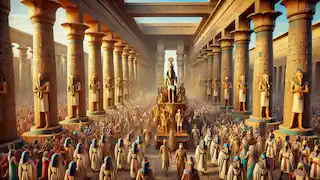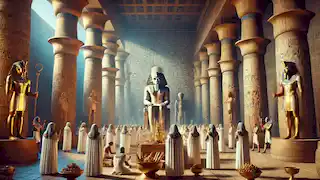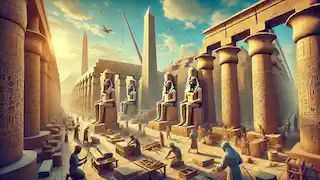In the golden sands of ancient Egypt, beyond the pyramids and through the whispers of the wind, the god Amun's tale was birthed, spanning eons and reaching far into the lives of Egyptians. Amun was no mere deity; he symbolized the unseen, the mysterious, and the boundless. His presence permeated the lives of pharaohs and peasants alike, a figure of reverence, power, and mystique.
As his legend unfolds, we journey from the sacred city of Thebes, where Amun’s worship grew, to the shifting sands of the Nile, and to the temples that echoed his praises. This is the tale of Amun, the “Hidden One,” a god who held the essence of Egypt’s divine and worldly realms within his hands, inspiring love, fear, and awe across millennia. The story begins in Thebes, a city of significance to Egyptian civilization, where Amun’s influence first began to take root. In its early days, Egypt was a land where nature and gods were interwoven, and each force of nature had a spirit, each mystery its deity. Amun was initially a local god of air and wind, mysterious and unseen, yet present in all things. The Egyptians of Thebes worshiped him in his early forms, revering him as a god of life and breath. As the political influence of Thebes rose in Egypt, so too did the stature of Amun. Over time, Amun transformed from a relatively obscure god into one of Egypt’s most important deities, merging with Ra, the sun god, to become Amun-Ra. This merging represented not only the union of air and light but also the ascendancy of Thebes and the god who had watched over it. Amun-Ra became the all-encompassing power of creation, symbolizing both the mysterious and the visible realms. The New Kingdom era saw the emergence of Theban kings who, empowered by their belief in Amun, expanded Egypt’s territory, wealth, and influence. Pharaohs like Hatshepsut, Thutmose III, and Ramesses II were devout followers of Amun, attributing their victories and prosperity to his blessings. In the grand temples they built in Thebes, particularly the Karnak Temple, these rulers honored Amun with offerings, prayers, and elaborate ceremonies. The Karnak Temple, with its towering columns and vast courtyards, was a tribute to Amun’s might. Every year, the Festival of Opet celebrated Amun’s union with his wife, Mut, and their son, Khonsu. A statue of Amun was paraded from Karnak to Luxor in a grand procession that drew thousands, symbolizing the god’s active role in the king’s governance and the land’s fertility. The kings were seen as Amun’s earthly representatives, a divine connection that assured their subjects of prosperity. Under the aegis of Amun, Egypt’s New Kingdom flourished, becoming a beacon of power and culture across the ancient world. Amun was known as the “Hidden One,” an invisible force that moved silently, influencing all aspects of life without being seen. His association with invisibility was profound, symbolizing the unknowable aspects of existence, from the workings of the universe to the mysteries of the soul. Amun was a god who was everywhere and nowhere, a paradox that made him both distant and intimate to his worshipers. The priests of Amun were among the most powerful in Egypt, serving as intermediaries between the god and the people. They wielded significant influence, not only in religious matters but also in political decisions. The priesthood of Amun maintained his mystique, emphasizing the god’s presence in unseen, sacred spaces, accessible only to those deemed worthy. In art, Amun was often depicted with a crown of two tall feathers, symbolizing his elevation above all other gods and his connection to the heavens. His portrayal as a ram or as a man with a ram’s head further emphasized his generative and powerful nature, aligning him with fertility and creation. Amun’s role extended beyond the mortal world, influencing beliefs surrounding the afterlife. As a god of creation and sustenance, he was thought to guide souls through their journey in the afterlife, providing them with the spiritual sustenance needed to reach the Field of Reeds, a paradise for the virtuous. The Egyptian Book of the Dead contains numerous references to Amun, showing his importance in the ritualistic aspects of death and the promise of rebirth. Pharaohs and common people alike prayed to Amun for a peaceful afterlife, believing that he could provide them with protection from chaotic forces. His influence over life and death cemented his status as a universal deity, relevant to every aspect of existence. Tombs and temples contained inscriptions and images of Amun, asking him to grant safe passage to the deceased, demonstrating his central role in Egyptian eschatology. The rise of Akhenaten, a pharaoh who initiated a religious revolution, marked a controversial period in Amun’s story. Akhenaten promoted the worship of Aten, the sun disk, elevating it above all other gods and attempting to diminish Amun’s influence. He moved the capital from Thebes to Amarna and ordered the defacement of Amun’s images in temples across Egypt. For a brief period, it seemed as though Amun’s power might fade. However, Akhenaten’s religious changes were short-lived. After his death, his successors restored the worship of Amun and dismantled the new religious structures he had imposed. This resilience illustrated Amun’s deep-seated importance in Egyptian culture and society, and he emerged from the turmoil more revered than ever. The story of Amun, post-Amarna, highlighted his resilience as a deity and the devotion of the Egyptian people to his presence in their lives, reinforcing the concept that no man, not even a pharaoh, could diminish the power of the gods. With the return to Thebes and the resurgence of Amun’s worship, the Karnak Temple complex reached new heights of grandeur. Pharaohs like Ramesses III and Seti I contributed to the temple’s expansion, adding chapels, statues, and obelisks that honored Amun. The temple complex became a sprawling city in itself, showcasing the wealth and power that Amun represented. The Amun priesthood became incredibly wealthy and powerful, controlling vast lands and resources. Some records indicate that the wealth of the temple at Karnak rivaled that of the pharaoh himself, reflecting the enduring power Amun held over Egypt. The festival days continued to be occasions for lavish celebrations, affirming Amun’s central place in Egyptian society and the hearts of its people. As Amun’s fame spread beyond Egypt, his cult reached distant lands. In Nubia, he was worshiped as a central god, and temples were built in his honor. His influence even reached the Mediterranean, with depictions of Amun appearing in Greco-Roman art. Amun had become a god for all people, a deity of strength, fertility, and mystery whose reach knew no bounds. With the fall of Egypt’s last dynasties and the conquest by foreign empires, the worship of Amun began to wane. The once-glorious temples fell into disrepair, and the power of the priesthood diminished as the new rulers brought different gods and religions. The rise of Christianity and later Islam in Egypt saw a transformation in the country’s spiritual landscape, and Amun, like many ancient deities, was slowly forgotten. However, the temples of Karnak and Luxor remained, bearing silent testimony to Amun’s centuries-long reign. Although his formal worship ceased, the stories and legends of Amun continued, embedded in the stones and carvings that survived the passage of time. Modern archaeologists and historians rediscovered these ancient temples, reviving the tales of Amun for a new age. {{{_04}}} Today, Amun’s legacy can be seen in the awe inspired by Egypt’s ancient monuments, the fascination with its mythology, and the mysteries that continue to captivate scholars and enthusiasts worldwide. Amun embodies the enigmatic spirit of ancient Egypt—a blend of strength, wisdom, and an eternal quest for knowledge. His story is one of endurance, transformation, and the eternal connection between humanity and the divine. The legacy of Amun, the “Hidden One,” endures, a reminder of the mysteries that lie beyond human understanding and the divine forces that shape existence. His temples remain as sacred spaces, and his image, whether as a ram, a king, or a deity shrouded in mystery, continues to resonate with those who seek the ancient truths of Egypt’s golden sands.The Dawn of Amun’s Worship

Amun and the Rise of Theban Kings
The Mystical Attributes of Amun

Amun’s Role in the Egyptian Afterlife
Amun and the Controversial Reign of Akhenaten

The Golden Age of Amun’s Worship
The Decline of Amun’s Influence
Epilogue: Amun’s Legacy in the Modern World



















